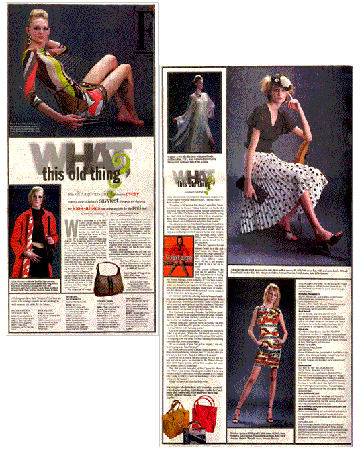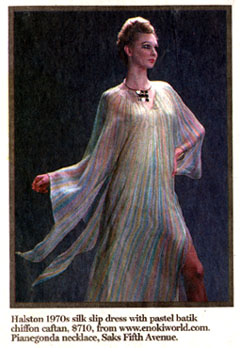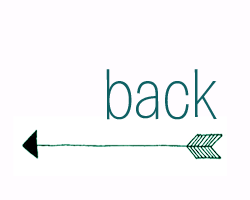 |
|
| With vintage-inspired clothes on every runway, some of fashion's savviest shoppers are skipping the look-alikes and going straight for the real deal.
By Kendall Morgan / Special Contributor to The Dallas Morning News What's hotter than an Yves Saint Laurent tuxedo, straight off the runway for 2001? An Yves Saint Laurent tuxedo circa 1972 – one that's sure not to show up on anyone else and that proves you're at least as hip as Chloe Sevigny or Kate Moss. What we've known as vintage clothing has changed. No longer the domain of thrift-shop chicks wearing musty '50s prom dresses and Dr. Martens boots, the new vintage is both exclusive and elusive – one-of-a-kind with a price tag to match. "Vintage is the ultimate individual clothing," says Cameron Silver, owner of the Los Angeles boutiques Decades and Decadestwo, where 1970s Ossie Clarks rub shoulders with '80s-era Stephen Sprouse and where a Norman Norell sable-trimmed coat from the 1960s may go for as much as $6,500. "You can't celebrate anyone other than the person wearing the outfit. [The dress] is not going to sell a bottle of fragrance." Siri Ahearne, of the Dallas vintage institution Puttin' on the Ritz, agrees. "People like to be one-of-a-kind. When you wear vintage, people ask you what it is, and you can say, 'It's vintage and you can't have it.' " The uniqueness of vintage clothes has not been lost on Hollywood's red-carpet set. When Demi Moore arrived at the Oscars in the early '90s wearing a lilac lace gown from the Beverly Hills vintage mecca Lily et Cie, the style world took note. Winona Ryder has made beaded gowns from the '20s and '30s a signature. And Ms. Sevigny's taste for classic Yves Saint Laurent has helped fuel the current '80s revival. "Somebody like Demi has been collecting since she was 16," says Tiffany Dubin, founder and former director of Sotheby's fashion department and co-author of the new book Vintage Style. "Los Angeles is very creative and has the best vintage shopping," she asserts. Clearly, celebs (and their stylists) aren't the only ones scouring stores for vintage Puccis, Guccis and Halstons. Contemporary designers have long mined the past for ideas. "Karl Lagerfeld goes on about how sick he is of borrowing from the past; then you look at his suits and they're totally Bonnie Cashin," says Madeline Meyerowitz, founder of the vintage-fashion Web shop Enokiworld.com. "You can't help it – there's nothing new." "Everything in life has been done already," agrees Keni Valenti, former designer for Fiorucci, "fashion historian" and founder of a self-named New York showroom offering designer clothes from the 1950s to the 1980s. "The human body has been the same for so long now [that] unless the Martians come down with six arms and new heads, we're not going to get a new silhouette. It's about styling – taking elements out of different eras and putting them together." Ms. Ahearne says scouts from Ralph Lauren and Donna Karan have visited her Snider Plaza shop, as well as collectors from pricey West Coast boutiques. At Decades, which recently added an outpost in the Barneys New York Madison Avenue store, shoppers from Jill Stuart, Gucci, Tommy Hilfiger and Versace have been spotted nosing around for the next big trend. What they happen to find and embrace "could be a total accident," notes Mr. Silver. "Say somebody has a huge collection of early '80s Kenzo and it looks fabulous. Four different vintage stores will buy it, and designers are going to see it and get inspired." For serious collectors, the hunt can be addictive. "I get great enjoyment out of finding things," says Dallas civic volunteer Brooke Aldridge, whose collection of Yves Saint Laurent, Chanel and vintage jewelry was culled from places such as Puttin' on the Ritz, Lily et Cie and Santa Fe Old West shows. "You don't just go into a store and buy something. There's a lot of imagination and whimsy associated with the hunt and wearing vintage. I look for it anywhere and everywhere I go." An inheritance sparked the collecting desire in Shannon Murchison, whose mother-in-law Jane Murchison spent a million dollars a year on clothes. "Her husband owned the Dallas Cowboys, and you've never seen anything like it," says Ms. Murchison. "There was James Galanos, Pucci – she had over 500 purses." Now Ms. Murchison shops all over the world to add to her collection. New York-based documentary filmmaker Liz Goldwyn (granddaughter of Samuel) has an amazing collection of vintage, including pieces by Claire McCardell and Rudi Gernreich, as well as dresses once worn by Ava Gardner and Jayne Mansfield. Although she says her collection "knows no bounds," she notes that she gets rid of things "to grow the collection. I like to trade. I'm a true believer in the bartering system." Like most vintage connoisseurs, Ms. Goldwyn has seen prices rocket in recent years. "When eBay first started, you could buy CourrŹges for $50 or $60, and now it'll be at least $300 to $700. I'm not going to pay that unless I've been searching for something forever or it has historical provenance. "If you go outside of New York or Los Angeles," she adds, "you're going to get better bargains." Ms. Dubin, who once scored a Bonnie Cashin jacket for $15 on eBay, recommends buying what you love. "If you buy what you love and you don't worry about it, it will have its moment." And if you love it, wear it. The most modern way is to mix vintage and current pieces, as illustrated in Ms. Dubin's Vintage Style, which depicts an array of New York socialites and scenesters wearing mixes of old and new. "Buy what you love, wear what you love," agrees Ms. Meyerowitz. "Don't hoard clothes. The designer intended it to be on a woman's body. If I had a choice to sell to a museum or to a woman who's going to wear it - even for less money - I'd so opt for selling it to the woman."
|


